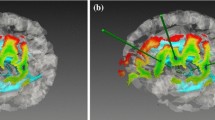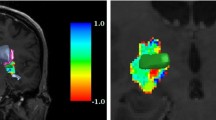Abstract
Purpose
Both frame-based and frameless approaches to deep brain stimulation (DBS) require planning of insertion trajectories that mitigate hemorrhagic risk and loss of neurological function. Currently, this is done by manual inspection of multiple potential electrode trajectories on MR-imaging data. We propose and validate a method for computer-assisted DBS trajectory planning.
Method
Our framework integrates multi-modal MRI analysis (T1w, SWI, TOF-MRA) to compute suitable DBS trajectories that optimize the avoidance of specific critical brain structures. A cylinder model is used to process each trajectory and to evaluate complex surgical constraints described via a combination of binary and fuzzy segmented datasets. The framework automatically aggregates the multiple constraints into a unique ranking of recommended low-risk trajectories. Candidate trajectories are represented as a few well-defined cortical entry patches of best-ranked trajectories and presented to the neurosurgeon for final trajectory selection.
Results
The proposed algorithm permits a search space containing over 8,000 possible trajectories to be processed in less than 20 s. A retrospective analysis on 14 DBS cases of patients with severe Parkinson’s disease reveals that our framework can improve the simultaneous optimization of many pre-formulated surgical constraints. Furthermore, all automatically computed trajectories were evaluated by two neurosurgeons, were judged suitable for surgery and, in many cases, were judged preferable or equivalent to the manually planned trajectories used during the operation.
Conclusions
This work provides neurosurgeons with an intuitive and flexible decision-support system that allows objective and patient-specific optimization of DBS lead trajectories, which should improve insertion safety and reduce surgical time.
Similar content being viewed by others
References
Kringelbach ML, Jenkinson N, Owen SL, Aziz TZ (2007) Translational principles of deep brain stimulation. Nat Rev Neurosci 8(8): 623–635
de Lau LML, Breteler MMB (2006) Epidemiology of Parkinson’s disease. Lancet Neurol 5(6): 525–535
Baltuch GH, Stern MB (2007) Deep brain stimulation for Parkinson’s disease, 1st edn. Informa healthcare, New York
Lind G, Schechtmann G, Lind C, Winter J, Meyerson BA, Linderoth B (2008) Subthalamic stimulation for essential tremor. Short- and long-term results and critical target area. Stereotact Funct Neurosurg 86(4): 253–258
Duval C, Panisset M, Bertrand G, Sadikot AF (2000) Evidence that ventrolateral thalamotomy may eliminate the supraspinal component of both pathological and physiological tremors. Exp Brain Res 132(2): 216–222
St-Jean P, Sadikot AF, Collins L, Clonda D, Kasrai R, Evans AC, Peters TM (1998) Automated atlas integration and interactive three-dimensional visualization tools for planning and guidance in functional neurosurgery. IEEE Trans Med Imaging 17(5): 672–680
Sadikot AF, Chakravarty MM, Bertrand G, Rymar VV, Al-Subaie F, Collins DL (2011) Creation of computerized 3D MRI-integrated atlases of the human basal ganglia and thalamus. Front Syst Neurosci 5: 71
Benabid AL, Chabardes S, Mitrofanis J, Pollak P (2009) Deep brain stimulation of the subthalamic nucleus for the treatment of Parkinson’s disease. Lancet Neurol 8(1): 67–81
Strafella AP, Vanderwerf Y, Sadikot AF (2004) Transcranial magnetic stimulation of the human motor cortex influences the neuronal activity of subthalamic nucleus. Eur J Neurosci 20(8): 2245–2249
Essert C, Haegelen C, Lalys F, Abadie A, Jannin P (2011) Automatic computation of electrode trajectories for deep brain stimulation: a hybrid symbolic and numerical approach. Int J Comput Assist Radiol Surg 1–16
Elolf E, Bockermann V, Gringel T, Knauth M, Dechent P, Helms G (2007) Improved visibility of the subthalamic nucleus on high-resolution stereotactic MR imaging by added susceptibility (T2*) contrast using multiple gradient echoes. Am J Neuroradiol 28(6): 1093–1094
Xiao Y, Beriault S, Pike GB, Collins DL (2011) Multi-contrast multi-echo FLASH MRI for targeting the subthalamic nucleus. Magn Reson Imaging
D’Haese PF, Cetinkaya E, Konrad PE, Kao C, Dawant BM (2005) Computer-aided placement of deep brain stimulators: from planning to intraoperative guidance. IEEE Trans Med Imaging 24(11): 1469–1478
Guo T, Parrent AG, Peters TM (2007) Automatic target and trajectory identification for deep brain stimulation (DBS) procedures. In: Ayache N, Ourselin S, Maeder A (eds) MICCAI 2007. LNCS, vol 4791, pp 483–490
McIntyre CC, Mori S, Sherman DL, Thakor NV, Vitek JL (2004) Electric field and stimulating influence generated by deep brain stimulation of the subthalamic nucleus. Clin Neurophysiol 115(3): 589–595
Butson CR, Cooper SE, Henderson JM, McIntyre CC (2007) Patient-specific analysis of the volume of tissue activated during deep brain stimulation. Neuroimage 34(2): 661–670
Nowinski WL, Yang GL, Yeo TT (2000) Computer-aided stereotactic functional neurosurgery enhanced by the use of the multiple brain atlas database. IEEE Trans Med Imaging 19(1): 62–69
Lee JD, Huang CH, Lee ST (2002) Improving stereotactic surgery using 3-D reconstruction. IEEE Eng Med Biol Mag 21(6): 109– 116
Nowinski WL, Volkau I, Marchenko Y, Thirunavuukarasuu A, Ng TT, Runge VM (2009) A 3D model of human cerebrovasculature derived from 3 T magnetic resonance angiography. Neuroinformatics 7(1): 23–36
Nowinski WL, Chua BC, Volkau I, Puspitasari F, Marchenko Y, Runge VM, Knopp MV (2010) Simulation and assessment of cerebrovascular damage in deep brain stimulation using a stereotactic atlas of vasculature and structure derived from multiple 3- and 7-tesla scans. J Neurosurg 113(6): 1234–1241
Navkar N, Tsekos N, Stafford J, Weinberg J, Deng Z (2010) Visualization and planning of neurosurgical interventions with straight access. In: Navab N, Jannin P (eds) IPCAI 2010. LNCS, vol 6135, Springer, Heidelberg, pp 1–11
Graves MJ (1997) Magnetic resonance angiography. Br J Radiol 70: 6–28
D’Haese PF, Pallavaram S, Li R, Remple MS, Kao C, Neimat JS, Konrad PE, Dawant BM (2012) CranialVault and its CRAVE tools: a clinical computer assistance system for deep brain stimulation (DBS) therapy. Med Image Anal 16(3):744–753
Vaillant M, Davatzikos C, Taylor R, Bryan R (1997) A path-planning algorithm for image-guided neurosurgery. In: Troccaz J, Grimson E, Mösges R (eds) CVRMed-MRCAS’97. LNCS, vol 1205, Springer, Heidelberg, pp 467–476
Fujii T, Asakura H, Emoto H, Sugou N, Mito T, Shibata I (2002) Automatic path searching for minimally invasive neurosurgical planning. Proc SPIE Med Imaging 4681: 527–538
Tirelli P, De Momi E, Borghese NA, Ferrigno G (2009) An intelligent atlas-based planning system for keyhole neurosurgery. Int J Comput Assist Radiol Surg 4(suppl 1): S85–S91
Fujii T, Emoto H, Sugou N, Mito T, Shibata I (2003) Neuropath planner-automatic path searching for neurosurgery. International Congress Series, vol 1256, pp 587–596
Brunenberg E, Vilanova A, Visser-Vandewalle V, Temel Y, Ackermans L, Platel B, ter Haar Romeny B (2007) Automatic trajectory planning for deep brain stimulation: a feasibility study. In: Ayache N, Ourselin S, Maeder A (eds) MICCAI 2007. LNCS, vol 4791. Springer, Heidelberg, pp 584–592
Shamir R, Tamir I, Dabool E, Joskowicz L, Shoshan Y (2010) A method for planning safe trajectories in image-guided keyhole neurosurgery. In: Jiang T, Navab N, Pluim J, Viergever M (eds) MICCAI 2010. LNCS, vol 6363. Springer, Heidelberg, pp 457–464
Danielsson P-E (1980) Euclidean distance mapping. Comput Graph Image Process 14: 227–248
Haacke EM, Mittal S, Wu Z, Neelavalli J, Cheng YC (2009) Susceptibility-weighted imaging: technical aspects and clinical applications, part 1. AJNR Am J Neuroradiol 30(1): 19–30
Haacke EM, Xu Y, Cheng YC, Reichenbach JR (2004) Susceptibility weighted imaging (SWI). Magn Reson Med 52(3): 612–618
Beriault S, Al Subaie F, Mok K, Sadikot AF, Pike GB (2011) Automatic trajectory planning of DBS neurosurgery from multi-modal MRI datasets. In: Fichtinger G, Martel AL, Peters TM (eds) MICCAI 2011. LNCS, vol 6891. Springer, Heidelberg, pp 259–266
Zrinzo L, de Hulzen AL, Gorgulho AA, Limousin P, Staal MJ, De Salles AA, Hariz MI (2009) Avoiding the ventricle: a simple step to improve accuracy of anatomical targeting during deep brain stimulation. J Neurosurg 110(6): 1283–1290
Elias WJ, Sansur CA, Frysinger RC (2009) Sulcal and ventricular trajectories in stereotactic surgery. J Neurosurg 110(2): 201–207
Sadowski EA, Bennett LK, Chan MR, Wentland AL, Garrett AL, Garrett RW, Djamali A (2007) Nephrogenic systemic fibrosis: risk factors and incidence estimation. Radiology 243(1): 148–157
Sled JG, Zijdenbos AP, Evans AC (1998) A nonparametric method for automatic correction of intensity nonuniformity in MRI data. IEEE Trans Med Imaging 17(1): 87–97
Nyul LG, Udupa JK, Xuan Z (2000) New variants of a method of MRI scale standardization. IEEE Trans Med Imaging 19(2): 143–150
Smith SM (2002) Fast robust automated brain extraction. Hum Brain Mapp 17(3): 143–155
Smith SM, Jenkinson M, Woolrich MW, Beckmann CF, Behrens TE, Johansen-Berg H, Bannister PR, De Luca M, Drobnjak I, Flitney DE, Niazy RK, Saunders J, Vickers J, Zhang Y, De Stefano N, Brady JM, Matthews PM (2004) Advances in functional and structural MR image analysis and implementation as FSL. Neuroimage 23(suppl 1): S208–S219
Fonov V, Evans AC, Botteron K, Almli CR, McKinstry RC, Collins DL (2011) Unbiased average age-appropriate atlases for pediatric studies. Neuroimage 54(1): 313–327
Collins DL, Neelin P, Peters TM, Evans AC (1994) Automatic 3D intersubject registration of MR volumetric data in standardized Talairach space. J Comput Assist Tomogr 18(2): 192–205
Collins DL, Holmes C, Peters T, Evans A (1995) Automatic 3D model-based neuroanatomical segmentation. Hum Brain Mapp 3: 190–208
Collins L, Zijdenbos A, Baare W, Evans A (1999) ANIMAL+INSECT: improved cortical structure segmentation. In: Kuba A, Šáamal M, Todd-Pokropek A (eds) IPMI 1999. LNCS. Springer, Heidelberg, pp 210–223
Coupe P, Manjon JV, Fonov V, Pruessner J, Robles M, Collins DL (2011) Patch-based segmentation using expert priors: application to hippocampus and ventricle segmentation. Neuroimage 54(2): 940–954
Frangi A, Niessen W, Vincken K, Viergever M (1998) Multiscale vessel enhancement filtering. In: Wells WM, Colchester ACF, Delp SL (eds) MICCAI 1998. LNCS, vol 1496. Springer, Heidelberg, pp 130–137
Essert C, Haegelen C, Jannin P (2010) Automatic computation of electrodes trajectory for deep brain stimulation. In: Liao H, Edwards P, Pan X, Fan Y, Yang G-Z (eds) MIAR 2010. LNCS, vol 6326. Springer, Heidelberg, pp 149–158
Yoo TS, Ackerman MJ, Lorensen WE, Schroeder W, Chalana V, Aylward S, Metaxas D, Whitaker R (2002) Engineering and algorithm design for an image processing API: a technical report on ITK—the insight toolkit. Stud Health Technol Inf 85: 586–592
Schroeder W, Martin K, Lorensen B (2002) The visualization toolkit, 3rd edn
Xu Y, Haacke EM (2006) The role of voxel aspect ratio in determining apparent vascular phase behavior in susceptibility weighted imaging. Magn Reson Imaging 24(2): 155–160
Petersen EA, Holl EM, Martinez-Torres I, Foltynie T, Limousin P, Hariz MI, Zrinzo L (2010) Minimizing brain shift in stereotactic functional neurosurgery. Neurosurgery 67(3 suppl operative): ons213–ons221
Zrinzo L, Foltynie T, Limousin P, Hariz MI (2012) Reducing hemorrhagic complications in functional neurosurgery: a large case series and systematic literature review. J Neurosurg 116(1): 84–94
Mercier L, Del Maestro RF, Petrecca K, Kochanowska A, Drouin S, Yan CX, Janke AL, Chen SJ, Collins DL (2011) New prototype neuronavigation system based on preoperative imaging and intraoperative freehand ultrasound: system description and validation. Int J Comput Assist Radiol Surg 6(4): 507–522
Mathur VK (1991) How well do we know Pareto optimality?. J Econ Educ 22(2): 172–178
Seitel A, Engel M, Sommer CM, Radeleff BA, Essert-Villard C, Baegert C, Fangerau M, Fritzsche KH, Yung K, Meinzer HP, Maier-Hein L (2011) Computer-assisted trajectory planning for percutaneous needle insertions. Med Phys 38(6): 3246–3259
Author information
Authors and Affiliations
Corresponding author
Rights and permissions
About this article
Cite this article
Bériault, S., Subaie, F.A., Collins, D.L. et al. A multi-modal approach to computer-assisted deep brain stimulation trajectory planning. Int J CARS 7, 687–704 (2012). https://doi.org/10.1007/s11548-012-0768-4
Received:
Accepted:
Published:
Issue Date:
DOI: https://doi.org/10.1007/s11548-012-0768-4




